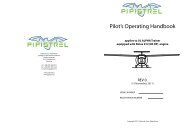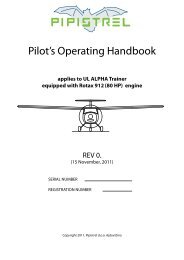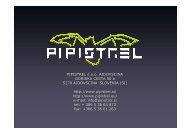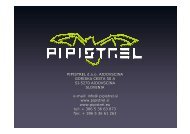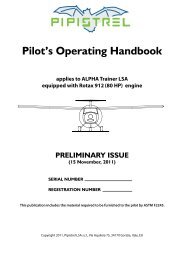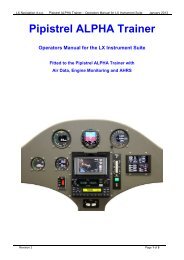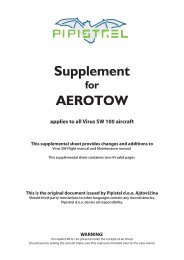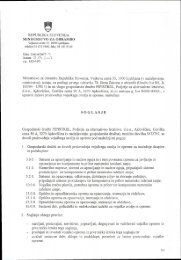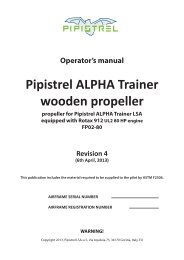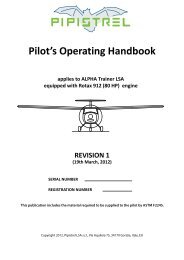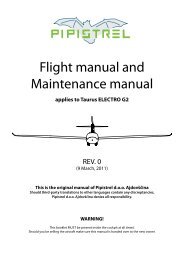Introduction - Pipistrel
Introduction - Pipistrel
Introduction - Pipistrel
You also want an ePaper? Increase the reach of your titles
YUMPU automatically turns print PDFs into web optimized ePapers that Google loves.
14 VIRUS SW www.pipistrel.si<br />
Limitations<br />
REV. 0<br />
<strong>Introduction</strong><br />
This chapter provides information about operational restrictions, instrument markings and basic<br />
knowledge on safe operation of aircraft, engine and on-board appliances.<br />
Operational velocities<br />
Speed limits<br />
VNE<br />
IAS up to<br />
4000 m/13100 ft,<br />
TAS above<br />
VRA<br />
Velocity<br />
IAS<br />
[km/h (kts)]<br />
Velocity never to be<br />
exceeded 302 (163)<br />
Remarks<br />
Never exceed this speed. Should the VNE be<br />
exceeded, land as soon as possible and have the<br />
aircraft verified for airworthiness by authorised<br />
service personnel.<br />
Maximum safe velocity<br />
in rough air 250 (135) Maximum speed in turbulent air.<br />
VA Manoeuvering velocity 174 (94)<br />
VFE<br />
VAE<br />
Max. velocity flaps<br />
extended 130 (70)<br />
Max. velocity of airbrake<br />
extention 205 (110)<br />
Airspeed indicator markings<br />
Do not use rough or full stick and<br />
rudder deflecions above this speed.<br />
Do not exceed this speed with flaps<br />
extended (+5, 19 degrees).<br />
Do not extend spoilers above this<br />
speed.<br />
MARKING IAS [km/h (kts)] Definition<br />
white arc<br />
70 -130<br />
(38 - 70)<br />
green arc<br />
86 -250<br />
(46 - 135)<br />
yellow arc<br />
250 - 302<br />
(130-163)<br />
red line<br />
302<br />
(163)<br />
Speed range where flaps may be extended. Lower end is defined<br />
as 110% of VS0 (stall speed in landing configuration at MTOM - 64<br />
km/h), upper end of speed range is limited by VFE (see above).<br />
Speed range of normal operation. Lower end is 110% of VS1 (stall<br />
speed at MTOM with flaps in neutral position - 79 km/h), upper<br />
end is limited by VRA (see above).<br />
Manouvre the aircraft with great caution in calm air only.<br />
Maximum speed allowed.<br />
blue line 140 (76) Best climb rate speed (V Y<br />
)<br />
Indicated airspeed (IAS) to true airspeed (TAS) relation<br />
Airspeed indicator measures the difference between total and static pressure (also called dynamic pressure),<br />
which does not only change as speed increases, but is also linked with altitude. Flying at high altitudes, where<br />
the air is getting thinner, results in misinterpreting airspeed which is being indicated. The indicated airspeed<br />
value is actually lower than the true airspeed to which the aircraft is exposed. The higher you fly, the bigger the<br />
difference between IAS and TAS. Be aware of this effect especially when flying at high altitude at high speeds,<br />
not to exceed VNE unawarely. Bear in mind this can happen even with the indicator still pointing within the yellow<br />
arc! However, for flight planning purposes TAS is the most accurate speed, which then can be corrected by<br />
eventual tail/head wind component to obtain the aircraft’s ground speed (GS).





